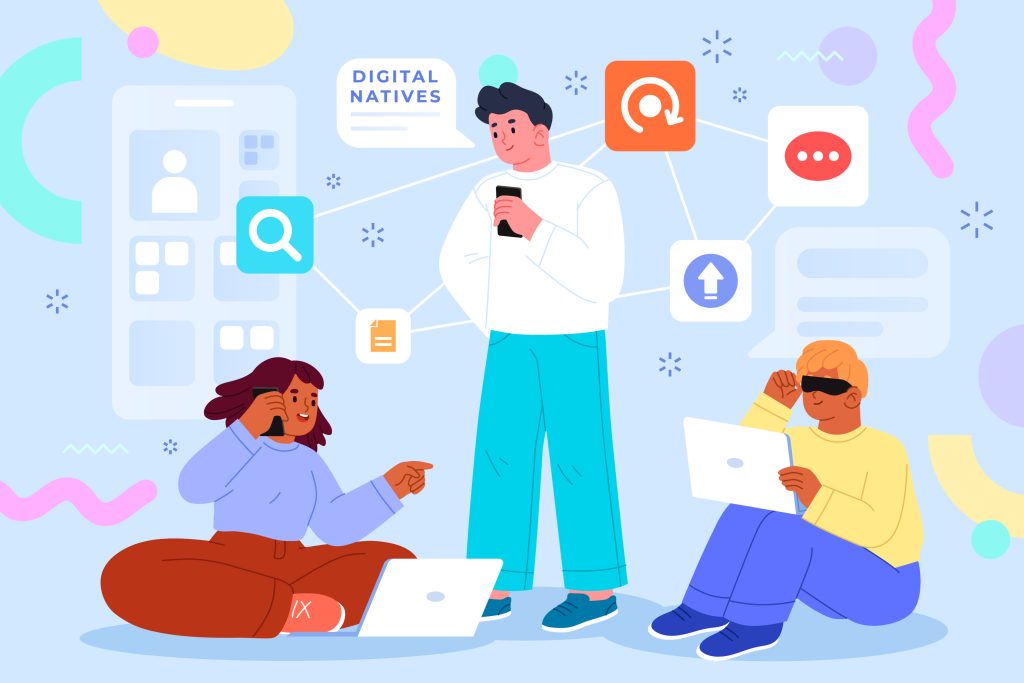In today’s digital age, the link between digital behavior and mental clutter is becoming increasingly apparent. Our constant engagement with screens, notifications, and social media is creating a mental overload, making it harder to focus. Understanding this connection is crucial for anyone looking to reduce distractions and regain clarity in their everyday lives.

How Digital Behavior Fuels Mental Clutter
Your average adult receives around 96 notifications per day—each pull to glance at your phone adds a bit more clutter to your mind. This constant partial attention creates cognitive load, making it harder to focus deeply. Researchers at the American Psychological Association found that multitasking weakens cognitive control and increases mental fatigue over time¹.
When we jump between emails, chats, and social feeds, our brains hardly recovered before being bombarded again. The result? A racing mind, forgetfulness, and a sense that your thoughts just aren’t your own.
The Current Tech Wellness Trend: Digital Decluttering
A growing trend in 2025 is the concept of digital minimalism, championed by Cal Newport, author of Digital Minimalism. People are reclaiming control by:
- Scheduling specific time blocks for email and social media
- Turning off all non-essential notifications
- Curating “low-stimulation” phone home screens
In fact, Apple’s recent iOS update highlights a new “Focus Filters” tool, allowing users to deeply filter notifications and limit mental clutter². This feature follows a shift towards tech that respects your attention, not hijacks it.
Warning Signs You May Be Too Digitally Mentally Cluttered
How can you tell if your digital behavior has gone too far?
- You struggle to complete a 30-minute task without checking your phone
- You feel unproductive or foggy even after small screen breaks
- Constant FOMO (fear of missing out) around online activity
A 2024 study showed that heavy social media use correlates with attention difficulties and lower life satisfaction—even after adjusting for other factors³.
Quick Strategies to Reduce Mental Clutter
Using evidence-based tactics, you can design a healthier digital life:
- Timed “Digital Sabbaths”
Dedicate 1–2 hours daily to be completely device-free (e.g., during meals or walks). This breaks the habit loop and lets your brain recharge naturally. - Notification Rehab
Audit all app alerts. Only enable communication tools you use daily—disable everything else. It’s a small step with big payoff. - Monochrome Home Screen
Remove color and vibrancy from app icons (put them in folders or gray them out). Trick your brain into seeing them as less urgent. - Single-Task Then Rest
Work with deep 25–30 minute Pomodoro blocks focused on one task, followed by a 5-minute digital break. Repeat and take longer offline breaks every few cycles. - Digital Journaling
Capture fleeting thoughts in a quick note app or physical notebook. Clearing your mental cache ensures less clutter and more clarity.
Emerging Trend: AI-Powered Digital Wellbeing
In mid‑2025, several new apps are using AI to coach users toward healthier screen habits:
- MindfulTech.ai analyzes your usage and nudges you to take breaks when it detects fatigue
- DetoxBot provides voice-based summaries of daily device use and suggests a “digital cleanse” when needed
These AI tools function like personal digital wellness coaches—neutral guides encouraging reflection rather than fear-mongering. Early user trials show reduced stress levels and more mindful device use.
A 7-Day Plan to Break Digital Overload
Here’s a structured weekly plan to declutter your digital life:
| Day | Focus | Actions |
|---|---|---|
| Day 1 | Awareness | Track screen time and notification count. |
| Day 2 | Notification audit | Turn off nonessential alerts. |
| Day 3 | Digital Sabbath | One 2‑hour device‑free block during the day. |
| Day 4 | Pomodoro setup | Complete 2 Pomodoros with full attention, no device interruptions. |
| Day 5 | App curating | Delete redundant or time-wasting apps. |
| Day 6 | Monochrome home screen | Simplify your interface. |
| Day 7 | Evaluation + reset | Review changes and plan the next week’s tweaks. |
Combining research-backed steps creates gradual change. By Day 7, most people report clearer thinking, better emotional regulation, and healthier screen relationships.
Benefits You Can Expect
- Better focus: Studies show reducing device distractions can boost productivity by up to 60%⁴.
- Lower stress: Fewer notifications and mental load result in calmer days.
- Better sleep & mood: Reduced screen time before bed improves rest and emotional balance.
These aren’t just feel-good promises—they’re measurable results backed by peer-reviewed science and featured by tech wellness writers.
Tech Meets Mindfulness: Staying Ahead
As digital minimalism enters the mainstream, keep an eye on:
- AI Digital Coaches: From wearable-integrated nudges to mobile assistants that learn your behavior.
- Smart Environments: Devices that intelligently adapt notifications based on time, location, or mood.
- Cross-device focus policies: Features like Apple’s Focus Filters will become more intricate and interoperable.
Embrace them—but always with mindful intent.
Final Thoughts
Health in the digital age isn’t about escaping tech—it’s about regaining control. Intentional tweaks and tech-aware habits are key. By taking small steps now, you declutter your mind, protect your attention, and set a foundation for long-term digital wellness.
References
- American Psychological Association (2023) The Cognitive Costs of Multitasking. Available at: https://www.apa.org (Accessed: 26 June 2025).
- Apple (2025) Focus Filters in iOS 18. Available at: https://www.apple.com (Accessed: 26 June 2025).
- Tandoc, Edson C. (2024) Social Media Use and Mental Health: A Meta-Analysis. Available at: https://link.springer.com (Accessed: 26 June 2025).






